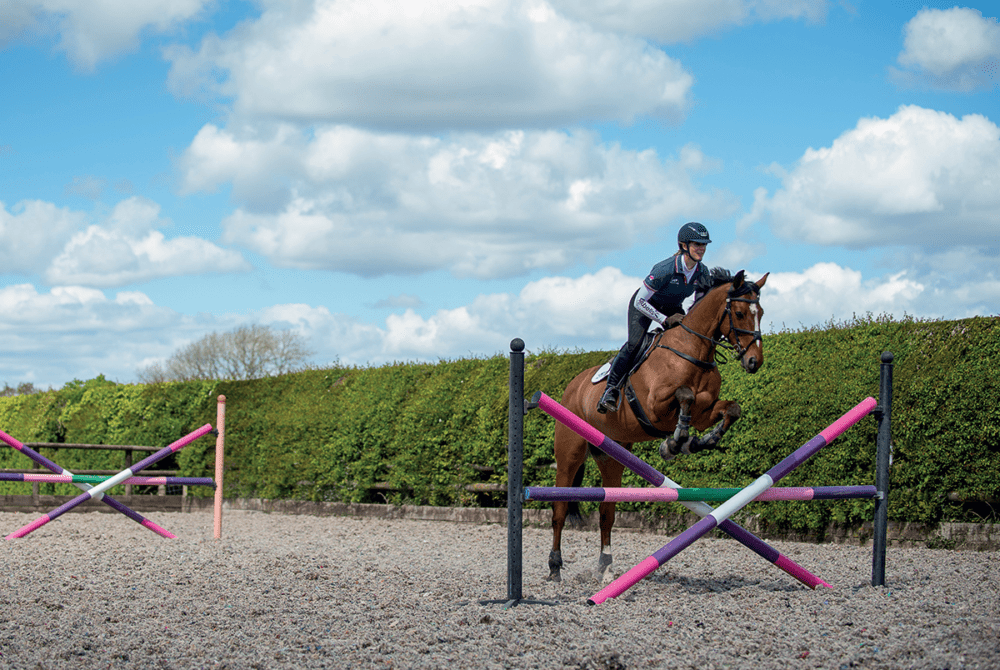Setting realistic expectations over fences with Lydia Hannon
Posted 22nd December 2021
Last month we covered how getting your horse out of the arena and off-grid can help to develop his core strength, control and balance. In part four of the series, Lydia Hannon talks about bringing these gains to your training over fences

Horses, like people, can be entirely different from one day or week to the next, and your challenge as a rider is to identify and respond to that. By doing so, you’ll keep your horse feeling engaged with your training sessions while nurturing and retaining his positive attitude to work.
Although you want to make sure your training’s generally following an upward curve, it’s important to accept regular fluctuations in the level and quality of the work. What he finds easy on one day may be more challenging and require a bit more work on another. This is absolutely normal and doesn’t mean either you or your horse is failing – horses aren’t machines and you can’t expect them to be able to do everything perfectly all the time.
So, rather than focusing on the height or technicality of the jumps, redefine your session goals by making them more about the quality of work you produce, even if it varies in level. This is your recipe for success. Much can be said for shifting your expectations should your horse find something you’re asking tricky on a given day. There’s far more to be gained from finishing on a good note, instead.
Top tip
Don’t fall into the trap of thinking that you need to jump endlessly, but instead focus on what you want to achieve from your session and stop when you’ve done so.
What’s a related distance?
A related distance is any distance of six strides or fewer between two fences. When two fences are sited on a related distance in a course, the designer will have measured a specific line that horses should take to meet both fences on the correct striding.
The magic three
I like to use related distances on my jump training days, and my favourite distance is three strides. Let me explain…
A two-stride distance is very demanding for your horse and leaves you with little time or space to make adjustments between the fences, should you need to. Conversely, a distance of 4–6 strides allows your horse more breathing space and requires less connection, meaning that he won’t take the same level of benefit from the exercise.
A three-stride distance won’t necessarily teach a rushing horse to slow down, but it’ll encourage him to connect through his body. This exercise isn’t about fence height, so don’t set them too high – it’s important that your horse feels he can pop over the first fence, then land and travel through the exercise in the same rhythm and balance as on the approach.
Exercise 1: Three-stride upright crosses
Set it up: Build two fences on the long side of your arena three strides apart (13.7–14.6m, depending on your horse’s stride length). Use three poles per fence to allow you to set up a high cross-pole with an upright horizontal pole through the middle, which you can adjust the height of. This design encourages your horse to use the correct technique, jumping straight and centrally.
What are you trying to achieve? The idea is to approach the fence off the corner and jump through the exercise in the same canter. Focus on your horse’s technique, rather than scope and ability. The aim is for him to pop over the first fence and remain in balance on the approach to, over and away from the second element.
How to do it: Although the distance between the two fences is set at a relatively easy three strides, start by asking your horse to travel down the line in four. This means he’ll need to pop in rather than over-jumping the first part and running out of space in the middle. On the approach and between the fences, concentrate on keeping your horse in rhythm and balance in between, using subtle, quiet aids.
Get more useful exercises and tips including handling an overenthusiastic jumper with Lydia Hannon in February Horse&Rider on sale 30 December 2021











